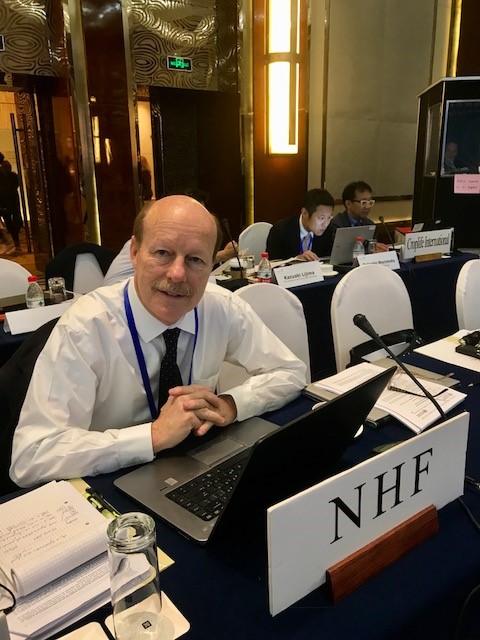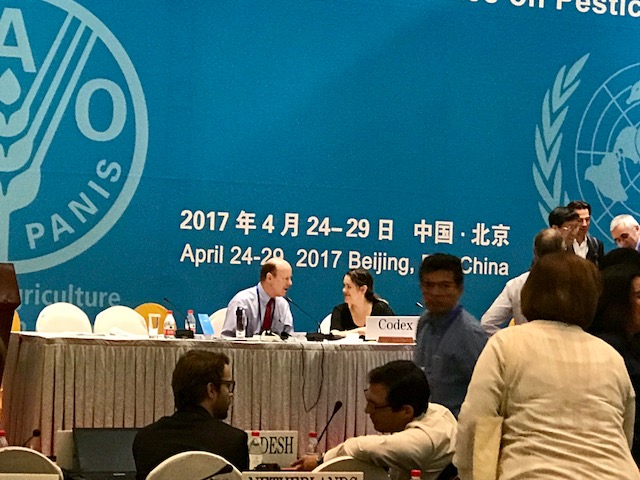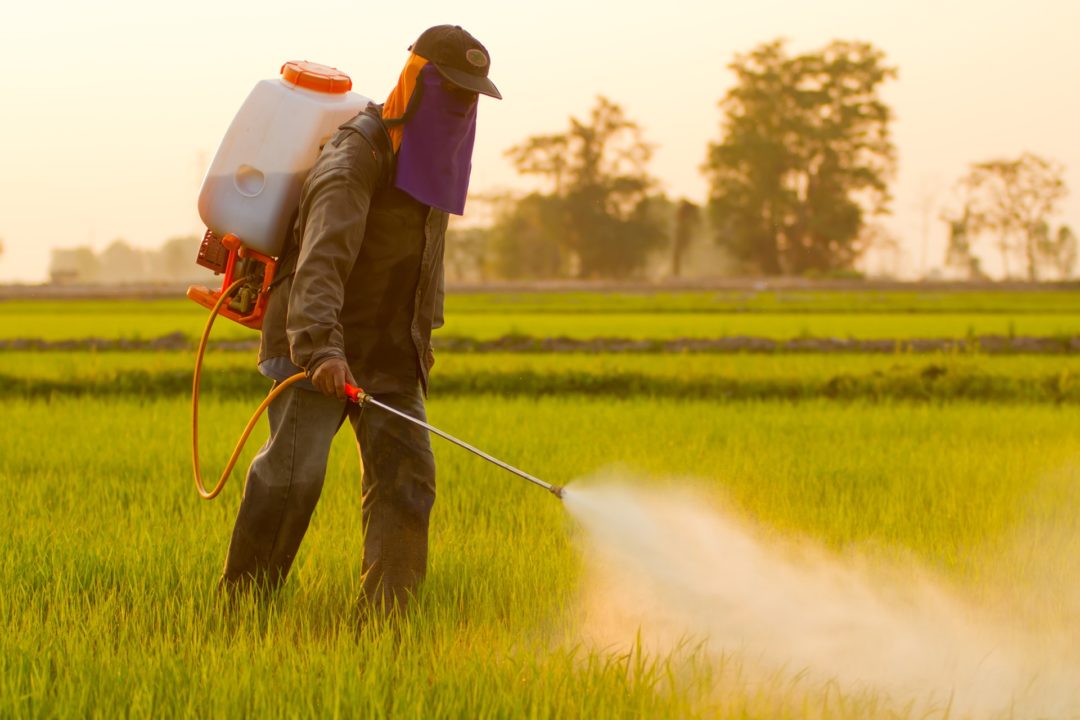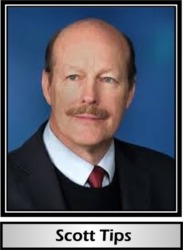“A business that makes nothing but business is a poor business.” - Henry Ford
They have been running amok for years, unchallenged. The Codex Alimentarius Committee on Pesticide Residues (CCPR) is their playground and they know it. Monsanto, Syngenta, DuPont, Dow, Bayer and other agrochemical companies — cozily snuggled together at Codex as the disarmingly named, front group CropLife — sent no fewer than 39 representatives to the 49thsession of the CCPR meeting held in Beijing, China from April 24-29, 2017, to coerce, charm and bedazzle government regulators. And many of those regulators, especially the Australian and New Zealand ones, have long been seduced into believing that pesticides can be safely applied in near endless amounts and varieties. Or, they simply do not care about the ill-health effects of it all.The Problem
That is why over one billion pounds of pesticides are used in the United States each and every year, while approximately 5.6 billion pounds are used worldwide (1). In many developing countries, programs to control pesticide exposures are limited or non-existent. The agrochemical companies tell us these compounds are safe and are ensuring adequate food production to feed the World, but the facts tell us another story.
On January 24, 2017, the United Nations (UN) published a report in which it stated that although pesticide use has correlated with a rise in food production, it has hadcatastrophicimpacts upon human health and the environment. The report went on to say that “[e]qually, increased food production has not succeeded in eliminating hunger worldwide. Reliance on hazardous pesticides is a short-term solution that undermines the rights to adequate food and health for present and future generations.” In fact, the UN blames pesticides for poisoning 200,000 people each year (2). I think that figure is wildly conservative (3).

Glyphosate tops the list of poisons applied every day to plants and soil that in turn destroy humans, animals, and our environment. Some 9.4 million tons of glyphosate have been spread on our fields. It is in our water table, our soil, crops, the food industry, and over 90% of Westerners have it in their bodies and even breastmilk. Despite industry assurances that glyphosate is “safe” and “environmentally friendly,” there is increasing awareness that glyphosate is nothing more than a replay of DDT with its similar pronouncements of “certified safe” and “completely harmless” (4). In fact, some experts attribute tens of thousands of deaths to glyphosate usage (5).
Worse, as Sayer Ji, founder of GreenMedInfo and NHF Vice-Chairman has said, glyphosate is poisoning our soil, destroying our gut biome, and laying the foundation for destroying our ability to produce healthy foods for future generations (6). Industry and regulators claim that glyphosate is safe for humans and animals because the means by which it kills weeds (the shikimate pathway) is not present in humans and animals. However, the shikimate pathway is present in bacteria, which dominate human and animal gut biomes. The glyphosate preferentially destroys beneficial gut bacteria, thereby allowing disease and inflammation to take hold (7).
The Solution
The quick solution to the glyphosate problem is to do exactly what was finally done to the nasty pesticide DDT: Ban it. Glyphosate is a deadly and persistent poison that affects more than just plant and animal and pollinator life, it harms many different aspects of the environment as well. And yet glyphosate is not the only herbicide and pesticide that deserves our immediate attention.
That was apparent at the most recent CCPR meeting in Beijing, where a growing list of approved and soon-to-be-approved pesticides was before the Committee for its consideration, a list that included chlorpyrifos-methyl, buprofezin, teflubenzuron, saflufenacil, fluazifop-p-butyl, flupyrdifurone, and glyphosate.
The Meeting
I knew from past experience at other Codex meetings that the poison pushers at this meeting would be Monsanto, Dow AgroChemical, Syngenta, Bayer CropScience, BASF, Adama, DuPont Crop Protection, and Nichino (all under the umbrella of CropLife or else sprinkled amongst various country delegations) as well as Australia, New Zealand, and some other industry-captured countries. On the other hand, NHF’s allies would be the European Union (EU) and Norway, with the Codex Secretariat being a very fair referee providing a level playing field for all delegates. In the event, this assessment proved to be exactly true.
Armed with the research provided by talented NHF researcher Arya Vrilya and NHF’s Executive Director Katherine Carroll, I then spoke out over the next four days against chlorpyrifos-methyl, buprofezin, teflubenzuron, saflufenacil, fluazifop-p-butyl, flupyrdifurone, glyphosate, and more (8). Depending upon the pesticide, NHF argued that they were carcinogenic, killed bees and other vital insects as well as aquatic life, and damaged the environment, including the oceans in the case of glyphosate.

The EU delegates Marco Castellina and Veerle Vanheusden were quite good and made “reservations” for the record about the draft Maximum Residue Limits (MRLs) for numerous pesticides. The Norway delegate tagged along for the ride with the EU, also stating its own reservations. However, know that when a country states areservationabout a particular pesticide, it is not opposing the advancement of that pesticide’s proposed MRLs to final adoption; rather, the country is simply stating that regardless of whether Codex adopts those MRLs or not, the “reserving” country will not be accepting that MRL within its country. At least European consumers will be protected from many of these dangerous pesticides.
On behalf of NHF members and consumers worldwide, I not only objected strenuously to the many pesticides already mentioned but also supported the EU’s and Norway’s efforts to revise the so-called IESTI equations. IESTI stands for the “International Estimate of Short-Term Intake” and these mathematical equations are used to estimate one-day exposures to acutely toxic chemicals in foods (9). The Europeans feel that the current IESTI equations used to set MRLs are not sufficiently protective enough of certain consumers and might result in short-term dietary exposure exceeding the Acute Reference Doses (ARfDs) even when the pesticide residue levels comply with the MRLs. NHF agrees, especially when one realizes that no one has ever really tested the synergistic and cumulative effects of these poisons nor considered that the safety studies submitted to regulatory agencies may be invalid (10). Additionally, bio-individuality is never considered; individuals have differing abilities to properly detoxify poisons. In the end, an electronic working group was established to explore changing the IESTI equations but it was quite plain that Australia, Kenya, and the United States, who are quite comfortable with the status quo, would simply play the “study it to death” game as they ran out the clock on any changes.
Mountains of Gold and Silver
Of course, CropLife and its captured regulators in Australia and New Zealand did all that they could during the meeting to advance pesticide MRLs that fail to protect consumers but do protect worldwide sales. The European countries seemed increasingly isolated in their efforts to protect consumers, while most member-country delegates either did not speak at all or only spoke once or twice.
The noble words of Chinese Vice-Minister of Agriculture Xinrong Yu, which had opened the session on the meeting’s first morning, had been all-too quickly forgotten by many delegates. Mr. Yu had commendably said, “We prefer the green hills of Earth rather than mountains of gold and silver.” And for those who might have missed the meaning of such poetry he was even more direct, “This is about consumer health.”
But where were the consumer advocates to stand beside NHF at this meeting and protect consumer health? There was the EU, Norway, and sometimes Chile; but notably absent were Consumers International (CI), the International Consumers Action Organization (IACFO), and the International Baby Formula Action Network (IBFAN), all so prominent at other Codex committees but not here. With glyphosate appearing routinely in the breast milk of nursing mothers around the World, one would think that IBFAN especially would cry out against that travesty here. Sadly and shockingly, there werenoconsumer organizations present to speak against the continued poisoning of our Planet, of our bodies, and of the bees except the National Health Federation. Perhaps their budgets, as with NHF’s, does not permit them to attend every Codex meeting.
Vice-Minister Yu spoke no truer words when he mentioned the “mountains of gold and silver,” which, to my mind, accurately describes the goals of that $60-billion mega-corporation named Monsanto and others who would hide the truth about pesticide hazards.
The Report
The reading and correction of the Report on the final meeting day, Saturday, began routinely enough. Some words were added to the Report, some were stricken. The Codex Secretariat – led by Tom Heilandt, Gracia Brisco and Annamaria Bruno and charged with preparing the draft report – had done its usual thorough job. Then, the attacks began.
First, New Zealand complained that NHF’s comment against chlorpyrifos-methyl should not be included, arguing that NHF had spoken against another substance. But as both the Codex Secretariat and the FAO representative had carefully resolved any doubt during the meeting, New Zealand’s complaint went nowhere.
Next, CropLife wanted NHF’s comment about the ecotoxicity of teflubenzuronstrickenbecause Codex is supposed to be about human health and not ecological health. This provided me with a perfect opportunity to argue to the delegates once again how ecotoxicity leads to ill health and even death in humans and animals. CropLife would have been better off keeping silent because both the Codex Secretariat and Chairman Xiongwu Qiao rejected CropLife’s stingy demand anyway.
However, emboldened by CropLife’s attempt to strike NHF’s comments about teflubenzuron, Australia launched its own cheap shot against NHF by demanding thatallof NHF’s comments be stricken from the Report! In my 18 years of participating in global policy-setting at Codex, this level of desperation by a country threatened by NHF has never occurred. NHF was clearly making headway. Keep in mind that the Australian Codex Office is nothing more than a regional field office of the pesticide industry and you will understand why Australia would do this. In my experience, Australia has never properly represented the health interests of its own citizens (11).
Always the gentleman, the U.S. delegate David J. Miller refused to jump on the bandwagon and more sensibly proposed some wording changes that would preserve NHF’s comments. But Australia argued on.
The Codex Secretariat and the Chairman acted properly and are to be much commended when they flatly refused to tolerate these cheap shots and instead made sure that NHF’s seven reported comments remained in the final record.
Fulvic Acid
As counterpoint to the carnage wreaked by pesticides worldwide, organic fulvic acids are created by soil-based micro-organisms to make minerals and other nutrients assimilable by plants. Importantly, fulvic acid can and will neutralize glyphosate and even the deadly pesticide Paraquat (12, 13).
Our soils are sick from greed-based, irresponsible agricultural practices, pesticides, chemical fertilizers, erosion, and mineral depletion, all of which stop or reduce adequate microbial activity in the soil, rendering them sick and/or dead and sterile. Sick soils make for sick plants and sick plants make for sick humans and animals. The addition of fulvic acid to our diets and our soils may provide both a stop-gap and medium-term solution to this pesticide plague.
In the Meantime, the Planet Dies
The fight rages on. There are victories, such as in the 55 lawsuits filed against Monsanto in Northern California, where the court recently ordered release of Monsanto e-mails and other documents showing probable collusion between the company and the U.S. Environmental Protection Agency (14). And there are defeats, such as the recent decisions by the EU and Health Canada to extend approval of the weed killer Roundup for another 15 years (15).
One thing is certain, however, the truth about glyphosate and other dangerous pesticides is increasingly coming to light. Its days on the market are numbered, no matter what Monsanto does. The only question is how much longer will people, animals, insects, fish, and our environment continue to be harmed and killed before these pesticides share the fate of DDT and are discarded? Even then we know full well contraband chemicals continue to be used globally. But I also know that NHF will not stop its efforts at Codex to halt the international trade in these poisons nor stop educating others of the dangers of listening to anything but firm science and common sense. After all, we too prefer the green hills of Earth to mountains of gold and silver.
References
1. Michael C.R. Alavanja, “Pesticides Use and Exposure Extensive Worldwide,”Rev Environ Health, 2009 Oct–Dec; 24(4): 303-309, athttps://www.ncbi.nlm.nih.gov/pmc/articles/PMC2946087/.
2. Ryan Rifai, “UN: 200,000 die each year from pesticide poisoning,”Al-Jazeera, March 8, 2017, athttp://www.aljazeera.com/news/2017/03/200000-die-year-pesticide-poisoning-170308140641105.html.
3. Even the somewhat sexist Women in Europe for a Common Future (WECF) stated almost five years ago that “pesticides and harmful chemicals cause more than 900,000 deaths annually.”See WECF, “Pesticides and harmful chemicals cause more than 900,000 deaths annually,”WECF website, Oct. 10, 2012, athttp://www.wecf.eu/english/articles/2012/10/pesticides-africa.php.
4. Dr. Joseph Mercola, “Toxic Combo of Roundup and Fertilizers Blamed for Tens of Thousands of Deaths,”Mercola.com, April 8, 2014, athttp://articles.mercola.com/sites/articles/archive/2014/04/08/roundup-fertilizer.aspx.
5.Ibid.
6. Sayer Ji, “Roundup Herbicide Linked to Overgrowth of Deadly Bacteria,”Health Freedom News, Spring 2013, Vol. 31, No. 1, pp. 12-13.
7. Dr. Joseph Mercola, “Roundup and Glyphosate Toxicity Have Been Grossly Underestimated,”Mercola.com, July 30, 2013, athttp://articles.mercola.com/sites/articles/archive/2013/07/30/glyphosate-toxicity.aspx.
8. Also an important member of the National Health Federation delegation at CCPR.
9. WHO-FAO, “International Estimated Short-Term Intake (IESTI),” June 13, 2013, athttp://www.who.int/foodsafety/chem/guidance_for_IESTI_calculation.pdf.
10. Tyler Durden, “Monsanto Colluded With EPA, Was Unable To Prove Roundup Does Not Cause Cancer, Unsealed Court Docs Reveal,”Zero Hedge, March 15, 2017, athttp://www.zerohedge.com/news/2017-03-14/court-docs-prove-monsanto-collusion-epa-kill-cancer-study-admits-cant-say-roundup-do.
11.See, e.g., Scott Tips, “The Great Australian Health Mystery,” July 21, 2013, athttps://www.thenhf.com/codex/our-work-at-codex/3886-89the-great-australian-health-mystery-why-is-there-a-great-divide-between-the-australian-people-and-their-government-on-health-by-scott-c-tips.
12. Matthew Kilby & Graeme Sait, “Successful Forest Farming, Nutrition is the Key,”Global Land Repair, undated, athttp://www.globallandrepair.com.au/information/articles/successful-forest-farming/.
13. Fisher, AM, Winterle, JS, & Mill, T, (1967) “Primary photochemical processes in photolysis mediated by humic substances,” in Zika RG & Cooper WJ (Editors),Photochemistry of environmental aquatic system, (ACS Symposium Series 327), Washington DC, American Chemical Society, pp. 141-156.
14. Reynard Loki, “Has Monsanto Orchestrated A Massive Cancer Coverup? Unsealed Court Case Documents Point to a Scandal,”AlterNet, March 16, 2017, athttp://www.alternet.org/environment/has-monsanto-orchestrated-massive-cancer-coverup-court-case-documents-point-troubling.
15. Ciaran Moran, “Controversial weedkiller could be authorised for a further 15 years this week,”Farm Ireland, May 7, 2017, athttp://www.independent.ie/business/farming/tillage/controversial-weedkiller-could-be-authorised-for-a-further-15-years-this-week-35648179.html; Health Canada, “Re-evaluation Decision RVD2017-01, Glyphosate,” April 28, 2017, athttp://www.hc-sc.gc.ca/cps-spc/pubs/pest/_decisions/rvd2017-01/index-eng.php.

A graduate of the University of California at Berkeley Law School, Scott C. Tips currently practices internationally, emphasizing Food-and-Drug law, business law and business litigation, trade practice, and international corporate formation and management. He has been involved in the nutrition field for more than three decades and may be reached at (415) 244-1813 or by e-mail at scott@rivieramail.com.
Published in WholeFoods Magazine June 2017










